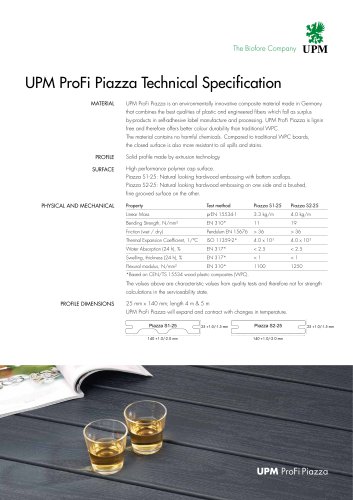
Catalog excerpts

Installation Instructions Building a deck out of ProFi just like timber. However, beautiful classic deck or an exciting design, it is important achieve a perfect result. Expansion Gaps: Important to remember All composite decks expand and contract with changes in temperature. This must be taken into account in the deck design. Failure to do so may result in damage to the As an approximate guide, when a deck is being built during a normal European Spring or Summer (ie above 1 0 degrees Centigrade), it is recommended to leave a 6mm gap for expansion in normal length boards (ie 3m and longer). • The simplest way to achieve this is to use the UPM ProFi T-Clip as a spacer. • The expansion gaps must be left at both ends of every Deck Board, Cover Strip and Support Rail used. • Smaller gaps may be left between short pieces. For more detailed information about thermal expansion, see the data supplied in the UPM ProFi Deck Technical Specification leaflet. There are two recommended foundations • using the ProFi Support Rails (40mm x 60mm) on a firm flat surface with good drainage: eg concrete or stone • using durable timber joists (eg 45mm load bearing frame. (It is important to note that the Support Rails are not load bearing, and may never be used as part of a structural frame) • the maximum recommended spacing of the Support Rails and timber joists is 400 mm from centre to centre. • it is important that the ProFi Support Rails or joists are all on the same level. 2. Laying the first Decking Board The first Decking Board is fixed to the Support Rails or joists with screws tongue of the outside edge of the Board. Either side may be used for the deck • Care should be taken to ensure that the edge of the Board is absolutely • The screws should be fixed at a • It is recommended that oval holes which are slightly larger than the screw (wider along the length of the Board) are predrilled in the Board to allow for thermal expansion. 3. Subsequent Decking Boards The inside edge of the first Decking Board and both edges of the subsequent Boards are fixed to the Support Rails (or joists) with the ProFi T-Clips and screws • Fix the T-Clips along the whole length • Use a longshaft screwdriver bit with a 6 mm diameter that fits the screw. • The drill torque must be adjusted so that the T-Clips are fixed tightly but not • Then insert the next Board under the lip of the T-Clip, using a rubber hammer to lightly tap the Board into • Repeat the process until the last Board.
Open the catalog to page 1
5. 4. Materials Needed • Decking Boards (28mm x 150mm): 6.6 m for each 1 m2 6 mm 4. Laying Decking Boards end to end When making a long deck with Decking Boards being laid end to end, both ends must be supported and attached to the Support Rail or joist. Using two Support Rails and T-Clips ensures adequate support and space for expansion. • Support Rails: (40 x 60mm) or timber joists (45mm x 145mm or 50mm x 150mm) 5. Laying the Last Decking Board The inside edge of the last Board is attached to the T-Clips, as with the preceding Boards. The outside edge is fixed to the Support Rails in the...
Open the catalog to page 2All UPM catalogs and technical brochures
-
UPM ProFi ®
12 Pages
-
BEST IN CLASS OUTDOOR LIVING
12 Pages
-
UPM ProFi Piazza
2 Pages
-
UPM ProFi® Deck
2 Pages
-
UPM ProFi® PRODUCT LIST 2020
17 Pages
-
UPM ProFi®
12 Pages
-
UPM ProFi
36 Pages
-
UPM ProFi® Patio
2 Pages
-
UPM ProFi DECKINGS
2 Pages
-
UPM PROFI® TERRA
2 Pages
-
UPM ProFi® Terra 127
2 Pages
-
UPM ProFiLifecycle S2-25
2 Pages
-
UPM ProFiLifecycle S1-21
2 Pages
-
UPM ProFi Piazza 2019
2 Pages
-
UPM ProFi Deck & Environment
2 Pages
Archived catalogs
-
UPM ProFi Quick Facts
2 Pages























